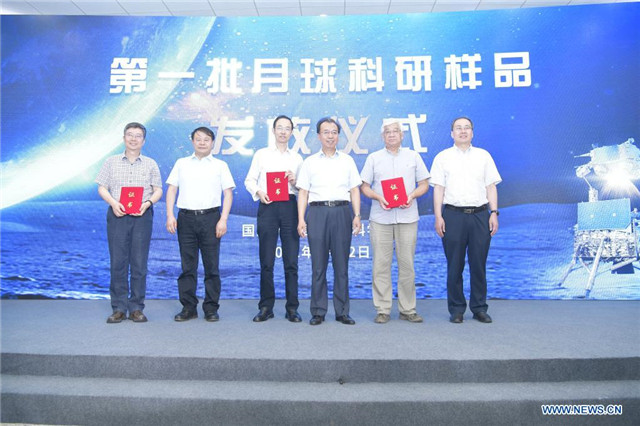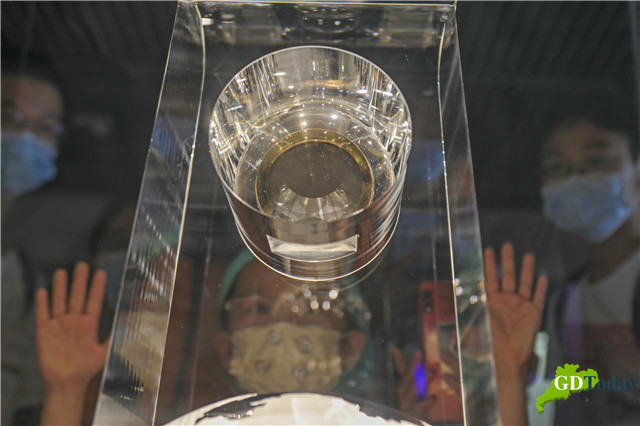On July 12, 17.4764 grams of moon soil samples from China's Chang'e 5 mission were doled out to 13 scientific institutions, among which Guangdong's Sun Yat-sen University (SYSU) received 500 mg of the lunar dust, including powder, rock debris and polished sections. In the coming weeks and months, scientists from Guangdong will conduct research on this sample.

Photo taken on July 12, 2021 shows the ceremony of delivering the first batch of lunar samples to research institutions in Beijing, capital of China. China on Monday delivered about 17 grams of lunar samples brought back by the Chang'e-5 probe to 13 institutions, which had applied for research programs to the Lunar Exploration and Space Program Center of the China National Space Administration. (Photo by Zhang Gaoxiang/Xinhua)
So far, the lunar soil sample collected by Chang'e 5 mission has been handed over to the research team from SYSU and was sent to their Zhuhai campus on July 13.
Why is SYSU eligible to apply for the lunar sample? How will SYSU utilize it? In what way did the research team "escort" the sample to Guangdong? Are the public going to be allowed access to have a glimpse of the lunar soil? For more details about the lunar sample SYSU received, here are some explanations from Xiao Zhiyong, associate professor of the School of Atmospheric Sciences of Sun Yat-sen University.

Lunar soil brought back by China's Chang'e-5 lunar probe is on display at the Shenzhen Museum from now till September 12, 2021. (Photo: Zhu Hongbo)
Q: Why is SYSU eligible to apply for lunar soil sample?
A: Sun Yat-sen University has a team conducting planetary geology research, with more than ten years of experience. The team's goal in this research is to extract the products formed in the lunar soil due to the impact and to carry out chemical analysis. By studying the composition of the material in it, we hope to analyze the process and history of impacts on the moon.
Q: How do you "escort" it to Guangdong? How will you preserve it in the future?
A: Before coming out of the lab, it is filled with nitrogen in a protective box to avoid contact with the air. Moreover, it is also contained in a safe box.
In accordance with the requirements of the Lunar Exploration and Space Program Center, SYSU has completely prepared the devices for the transportation, storage and protection of the sample. These devices will be preserved and analyzed under pure-nitrogen and extremely-dry environment. During the official research process, the sample will undergo operations of selection, classification and professional analysis in a sterile environment.
Q: The sample weighs only 500 mg, is it enough for research?
A: 500 mg is quite a lot. Decades ago, the United States gave 1 gram of moon soil to China as a national gift, and our country used half of it for research. In addition, among the universities that got the moon soil this time, SYSU was the one that got the most.
Q: Are the public allowed access to have a glimpse of the sample?
A: Apart from faculty and PhD students, SYSU encourages undergraduate students to participate in these studies and do some entry-level research.
The samples that we applied for this time are used for scientific research, not exhibition supplies. After the analysis of the sample, we will ask the regulators for permission to satisfy the curiosity of the public.

People view the lunar soil brought back by China's Chang'e-5 lunar probe at the Shenzhen Museum on July 13, 2021. (Photo: Zhu Hongbo)
Notes about lunar soil
Q: What is lunar soil?
A: Instead of hard rock, the moon's surface is covered with a layer of loose soil that scientists call "lunar soil".
Q: How does the lunar soil come into being?
A: There is no biological activity and organic matter involved in the formation of lunar soil in an extremely water-depleted environment. The mineral powder that makes up the lunar soil is basically formed by the impacts of meteorites.
In addition, the surface of the moon is often hit by meteorites. Due to the tremendous energy of impacts, part of the matters on the surface will fuse and turn into glass. Other matters will vaporize and recondense, serving as part of the lunar soil.
Q: Why do we need to collect lunar soil?
A: The lunar surface is almost covered by lunar soil, so research on lunar soil will affect the accuracy of the results of the circumlunar orbit probes.
Lunar soil is the preferred choice for lunar resources utilization in the future. The lunar soil contains abundant Atmosphere-3, which are roughly a million to ten million times the Earth's content. What’s more, Helium-3 in lunar dust is one of the optional fuels for nuclear fusion in the future.
The understanding and study of lunar soil is indispensable for lunar exploration, the establishment of lunar bases and the use of the Moon in the future.
Q: How do we use the moon soil?
A: ● The primary purpose is to conduct scientific research.
● Part of the samples will be preserved and displayed at the National Museum of China for public science education.
● Part of the lunar soil will also be shared with scientists ofcountries and the world according to related agreements. Some samples may serve as national gifts for other countries according to international practice.
Q: Why do we only collect 1,713 grams of moon soil?
A: Because the sampling process is quite complicated. The Chang'e lunar rover collects the lunar soil mainly through its robot arms. All operations require remote participation of human beings on Earth.
In addition to collecting soil, Chang'e 5 mission also carried a large number of instruments and equipment to investigate the lunar surface environment and geology with data analysis.
Q: Can we grow vegetables in lunar soil?
A: No. Lunar soil mainly consists of rocks, debris from rock beds, and glassy particles due to impacts. The particles are extremely fine in texture, but are as sharp as the tip of knife. Its chemical elements mainly include oxygen, silicon, and iron without any organic nutrients.
Author | Nancy (intern)
Editor | Olivia, Monica & Jerry




